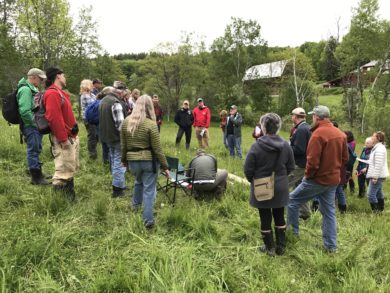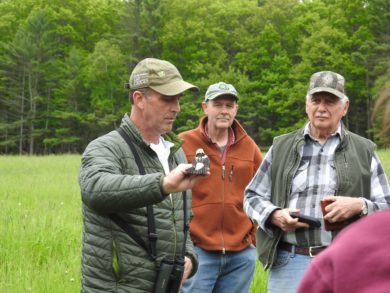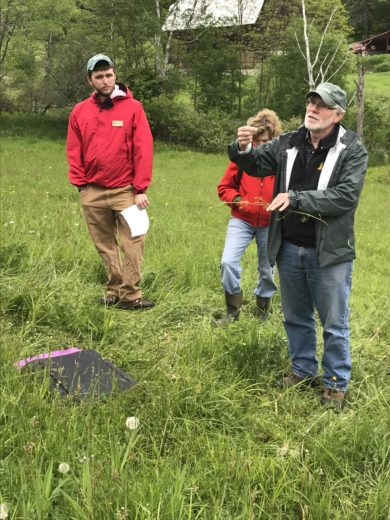
Landowners explore ways to support grassland birds that nest in hayfields in balance with other land objectives. / © R. Renfrew
Landowners Share Quandaries and Tips
Most landowners take pride in providing habitat for wildlife, including birds. The needs of nesting grassland birds, however, present some formidable challenges. Populations of grassland specialists such as Bobolink have been declining for decades, and some species depend heavily on hayfields for nesting. But hayfields are cultivated primarily for animal forage, not bird habitat. Can hayfields provide both forage and habitat?
On a cool, cloudy Spring day, we gathered with landowners and agronomists at a Bobolink-filled field in Norwich, Vermont to take on the question. “The Balancing Act: a Workshop for Landowners and Land Managers,” sponsored by VCE and the Upper Valley Land Trust (UVLT), brought agronomists together with landowners to share ways to strike a balance between forage production and stewardship for birds.
Although grassland birds sorely need quality nesting habitat, managing hayfields to allow them to fledge young can be complicated given often-competing objectives and constraints faced by landowners. After giving participants a close-up look at Bobolinks, VCE’s Roz Renfrew discussed the habitat needs and importantly, the undisturbed time the birds need to successfully fledge their young.

Michael Corcoran, a CT bird bander and VCE constituent, shows a male Bobolink to participants. / © R. Renfrew
Then we got into the weeds. Forester AJ Follensbee of VT Dept. Forest Parks and Recreation shared insights about how to prevent and control invasive plants that can thrive in hayfields, especially under delayed mowing, which can give them an advantage over desirable grasses. Sid Bosworth of UVM Extension talked about the compromises in forage nutrition caused by delayed mowing, and grass species and mixes that work best under delayed mowing regimes. Sylvia Harris of the Natural Resources Conservation Service emphasized soil health and encouraged people to explore support opportunities for those wishing to benefit birds. John Roe of UVLT wrapped up with the big picture of how grasslands management fits into the protection of all resources for future generations. Landowners shared their own experiences and asked insightful questions in what amounted to a valuable learning exchange for all.

Sid Bosworth of UVM Extension discusses grasses in hayfields, looking on is Forester AJ Follensbee of Vermont Dept. Forest Parks and Recreation, who gave tips for managing invasive plants. / © R. Renfrew
Participants gained a heightened sense of the opportunities and challenges, tips and tools, and collective interest in supporting grassland birds amidst other land use objectives. A big thanks to participants, speakers, co-sponsor UVLT, VCE grasslands outreach specialist Cathryn Abbott, and to Elizabeth Russell for hosting this successful event. VCE will continue to help landowners find ways to support grassland birds.

I loved seeing the pictures and hearing about the meeting that the cold weather, my age at 87 prohibited me from coming. I have a all the problems you describe, but I need some guidelines as to how to manage the invasives which my forester says I should mow down several times a year.
If i had been there I would have asked how we manage bird protection under a regime that requires mowing. I have gone out into the meadow and by hand cut and packaged up bags of invasive foliage before it bloomed and shed seed. I am not longer able to do this. What alternatives would I have learned if I had attended. Marcia Bushnell
I know I’m not alone in missing this and also wishing something with a lot more detail can be written up and made available.
VCE –
Thank you for this update. Is the information presented in this gathering available on-line? I am working with a local land trust in Washington state to develop a strategy for this issue. I have not yet found more local resources that address this management challenge.
In reply to all of the comments:
Thank you for your interest! We did not take notes during the workshop but there is lots of information available online. Note that invasives treatments, and nesting phenology and recommended mowing dates differ in different parts of the country/continent. Recommendations that apply in Vermont will not translate well to Ontario and especially as far away as Washington state. This is not only because the birds may vary in their nesting schedule (e.g., our research suggests that Bobolinks in Oregon nest at least week later than in Vermont), but also because agricultural plant species, timing, and practices will vary greatly. Also it depends on which species you’re focusing on. For example, Meadowlarks get a much earlier start and will often nest twice in a season, Bobolinks won’t have 2 broods.
For more information on the topic see our nesting phenology calendar, grassland bird management brochure, and NRCS leaflet.
And here’s another resource from Mass Audubon.
UVM Extension may be a resource for invasives and other hayfield management issues. For help with specific questions on your property related to grassland bird management, our grasslands outreach specialist may be able to squeeze you in, this season or next. Please email cabbott vtecostudies.org
Perhaps if there is enough interest we can hold another workshop next year.
Thank you for the information.